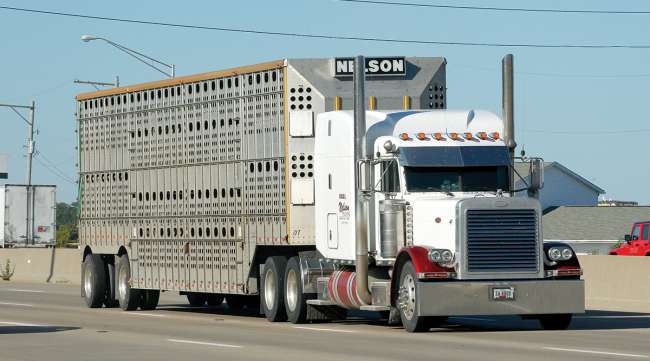Staff Reporter
FMCSA Clarifies Terms for Ag Haulers, Farmers

[Stay on top of transportation news: Get TTNews in your inbox.]
In an effort to help farmers — and the truckers who haul their products — the Federal Motor Carrier Safety Administration published an interim final rule clarifying some definitions associated with agricultural goods.
The interim final rule, released Nov. 19, clarifies the terms “any agricultural commodity,” “non-processed food” and “livestock,” each of which is included in the definition of “agricultural commodity.” Agricultural products are considered in federal hours-of-service regulations, as many such goods travel by truck.
“Our nation’s farmers and agriculture haulers will benefit from this clarification of the rules and will be able to deliver their products in a safer and more efficient manner,” FMCSA Deputy Administrator Wiley Deck said. “These improved rules will help farmers move commodities and get food to our grocery stores. We have heard the concerns from our farmers and ag haulers, and we’ve worked closely with [the U.S. Department of Agriculture] and the industry to provide regulatory clarity and craft this new rule.”

Deck
Currently, during harvesting and planting seasons that are determined by each state, drivers transporting agricultural commodities are exempt from HOS requirements while traveling from the source of the commodities to a location within a 150 air-mile radius of the source. Furthermore, drivers transporting livestock in interstate commerce are exempt from the 30-minute rest break rule while the livestock are contained in the commercial motor vehicle.
The agency has noted that the term “any agricultural commodity” is ambiguous. The interim final rule clarifies that horticultural products that are subject to “perishability or significant degradation in product quality during transport by CMV” fall within the meaning of “any agricultural commodity.” Plants such as sod, flowers, seedlings, shrubs and Christmas trees fall within the scope of the definition. Products that don’t risk perishability while in transit, such as timber, are not included.
USDOT/FMCSA Helps American Farmers and Commercial Drivers by Clarifying Agricultural Commodity Definitions https://t.co/6XAn22ban7 — FMCSA (@FMCSA) November 19, 2020
FMCSA also clarifies that “non-processed food” encompasses fruits, vegetables and cereal and oilseed crops that have been “minimally processed by cleaning, cooling, trimming, cutting, shucking, chopping, bagging or packaging to facilitate transport by CMV.” Products that have undergone “post-harvest changes,” such as jarring, canning, drying or freezing, are not considered “non-processed food.”
The agency interprets “livestock” as all living animals and insects cultivated, grown or raised for commercial purposes, including aquatic animals. This interpretation builds on a definition that already included cattle, elk, reindeer, bison, horses, deer, sheep, goats, swine, poultry, llamas, alpacas, live fish, crawfish and other animals that are part of a foundation herd or offspring.
The clarifications follow an advance notice of proposed rulemaking FMCSA published in July 2019 that sought public comment on revising these definitions. The ANPRM garnered 140 comments from groups such as farm bureaus, agricultural trade associations, sod haulers and trucking groups.

According to Shelley Dellinger of Cargo Transporters and Alphonso Lewis, ATA’s Road Team Captain and YRC Freight driver, diversity in recruitment methods is essential. Hear a snippet, above, and get the full program by going to RoadSigns.TTNews.com.
The ANPRM was prompted by indications that the current definitions of these terms may not be understood or consistently enforced when determining if the HOS exemption applies.
“FMCSA codifies these definitional clarifications to promote more consistent understanding of existing terms so the exemptions are utilized and applied consistently,” the Federal Register notice announcing the interim final rule states. “The ambiguity associated with the definitions of the exemptions currently may be hindering consistent enforcement practices, thereby impacting business-related decisions for the hauling of agricultural commodities and livestock, resulting in unnecessary costs and disbenefits.”
The Federal Register document notes that there are two groups of truck drivers whose operations may be impacted by the ruling: those to whom these definitions apply, but who do not use an exemption due to the definitional ambiguity, and those who use an exemption and may no longer do so as a result of the clarifications.

Home | Video | Heroes' Photo Gallery
Saluting the men and women of the trucking industry who kept America's essential goods flowing during the coronavirus pandemic.
Heroes: Peter Lacoste | Susan Dawson | James Rogers | Reggie Barrows | Kevin Cooper | Cesar Quintana Moreno
“Drivers who use these exemptions as a result of the clarification provided in this interpretative rule may potentially realize cost savings, and those who no longer use an exemption as a result of this clarification may incur costs,” the document states.
The interim final rule will take effect 15 days after it is published in the Federal Register. The ruling includes a 30-day comment period, which will be opened after the document’s publication in the Federal Register. The agency will consider and address these comments in the final rule that will follow this interim final rule, and may make changes to the rule in response to the comments received.
According to the U.S. Department of Transportation, the agriculture industry contributes more than $1 trillion annually to the nation’s economy.
“The agriculture industry is vital to our nation, and this new rule will provide clarity and offer additional flexibility to farmers and commercial drivers,” Transportation Secretary Elaine Chao said, “while maintaining the highest level of safety.”
Want more news? Listen to today's daily briefing:
Subscribe: Apple Podcasts | Spotify | Amazon Alexa | Google Assistant | More




